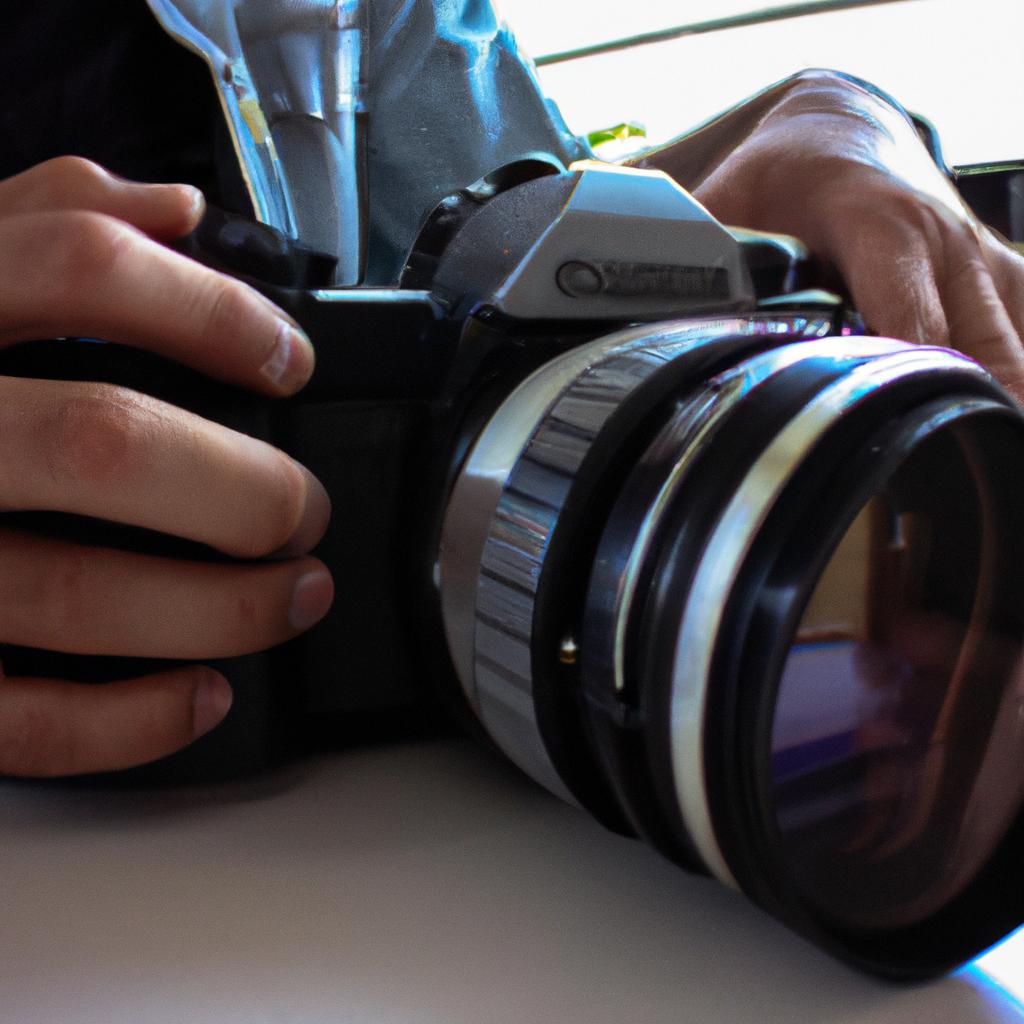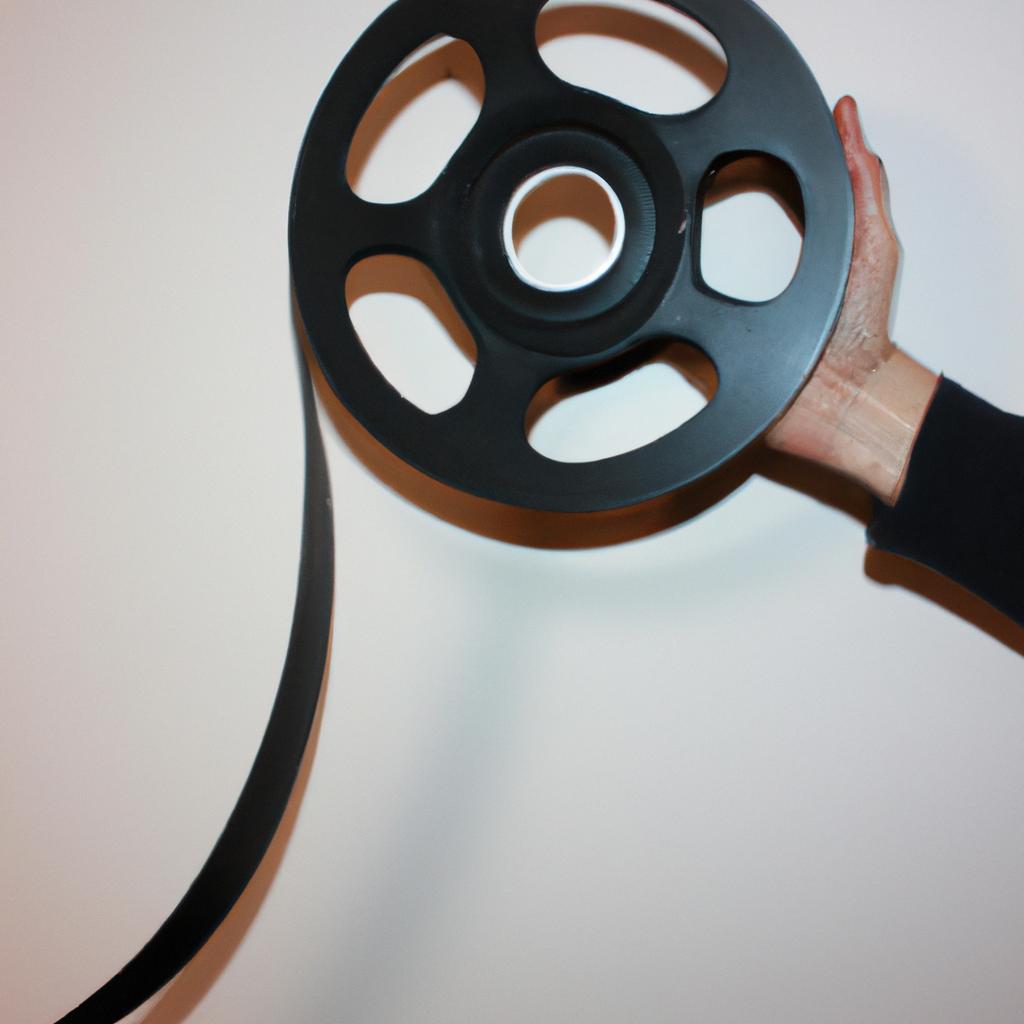The Art of Cinematography: Film in Arts and Entertainment

The art of cinematography plays a pivotal role in the world of arts and entertainment, enhancing visual storytelling and captivating audiences. Through the skilled manipulation of camera angles, lighting techniques, and composition, cinematographers have the power to transport viewers into different worlds, evoke emotions, and create lasting impressions. For instance, consider the critically acclaimed film “Citizen Kane,” directed by Orson Welles. In this masterpiece, Gregg Toland’s innovative use of deep focus photography revolutionized the way films were shot at that time and set new standards for cinematic excellence.
Cinematography can be seen as an intricate dance between technical expertise and creative vision. The meticulous planning involved in selecting cameras, lenses, filters, and other equipment is complemented by artistic choices such as color palettes, framing compositions, and movement within the frame. These decisions shape the overall aesthetic of a film and contribute to its narrative impact. A prime example of this synergy can be found in Christopher Nolan’s mind-bending thriller “Inception.” Wally Pfister’s expert control over various visual elements like perspective distortion through wide-angle lenses heightened the surreal atmosphere of dreams within dreams – illustrating how cinematography serves as a vital tool for filmmakers to express their ideas effectively.
By understanding the nuances of By understanding the nuances of cinematography, filmmakers can manipulate the mood and atmosphere of a scene. Choices such as the use of natural light versus artificial lighting, high contrast or soft lighting, and the placement and movement of the camera can all contribute to creating a specific visual tone. For example, in Martin Scorsese’s film “Taxi Driver,” Michael Chapman’s use of low-key lighting and shadowy compositions effectively conveyed the dark and gritty world inhabited by the protagonist.
Furthermore, cinematography also plays a crucial role in character development and storytelling. The framing and composition of shots can reveal information about a character’s emotional state or their relationship with other characters. In Steven Spielberg’s “Schindler’s List,” Janusz Kaminski’s decision to shoot many scenes from a handheld camera perspective created an intimate connection between the audience and the characters, enhancing empathy and immersion in the story.
In addition to artistic considerations, technical skills are essential for cinematographers. They must have a deep understanding of cameras, lenses, filters, and other equipment to achieve desired effects. Furthermore, they need to collaborate closely with directors, production designers, and other crew members to ensure that their vision aligns with the overall creative direction of the film.
Overall, cinematography is an art form that combines technical expertise with creative vision. Through careful manipulation of visual elements, it has the power to transport audiences into different worlds and evoke emotions. Whether it is through innovative techniques or subtle choices that enhance storytelling, cinematography remains an integral part of filmmaking that enhances its impact on viewers.
The Role of Cinematography in Visual Storytelling
Imagine watching a film with stunning visuals that transport you to another world, evoking strong emotions and leaving a lasting impression. This is the power of cinematography, an integral component of visual storytelling in the realm of arts and entertainment. Through careful manipulation of camera angles, lighting techniques, and framing choices, cinematographers play a crucial role in conveying the narrative and enhancing audience engagement.
One example that showcases the impact of cinematography is director Christopher Nolan’s 2010 science fiction thriller, “Inception.” In this film, cinematographer Wally Pfister skillfully employs various visual techniques to immerse viewers into the intricate dreamscapes explored by the characters. By using low-angle shots to emphasize dominance and high-angle shots for vulnerability, Pfister amplifies tension and heightens suspense throughout the movie. Additionally, his creative use of lighting contrasts helps establish distinct dream levels and enhances the overall surreal atmosphere.
Cinematography has the ability to evoke powerful emotional responses from audiences through its carefully crafted visual language. Consider these four elements:
- Lighting: The interplay between light and shadow can create mood and convey meaning within a scene.
- Composition: Thoughtful placement of subjects within the frame guides our attention and affects how we interpret their actions or emotions.
- Camera movement: Fluid tracking shots or dynamic handheld movements can generate excitement or unease depending on the context.
- Color palette: Manipulating color saturation or employing specific hues can elicit certain feelings or associations.
To further illustrate this point, let’s examine a table showcasing examples where different cinematic techniques have been used effectively:
| Technique | Film Example | Emotional Response |
|---|---|---|
| Low-angle shot | The Godfather | Empowerment |
| High-angle shot | Vertigo | Disorientation |
| Long take | Birdman | Intensity |
| Deep focus | Citizen Kane | Depth |
The influence of cinematography on audience experience extends beyond the visual aspect. By effectively utilizing techniques such as framing, movement, and lighting, filmmakers can shape our perception and heighten our engagement with the story’s themes and characters.
Transitioning into the subsequent section about “The Influence of Cinematography on Audience Experience,” we will delve deeper into how specific cinematic choices impact viewers’ emotional connection to a film. By exploring examples from different genres and analyzing their effects, we will gain a holistic understanding of the profound role cinematography plays in shaping our cinematic experiences.
The Influence of Cinematography on Audience Experience
Having explored the fundamental importance of cinematography in visual storytelling, we now turn our attention to its profound influence on audience experience. To illustrate this impact, let us consider a hypothetical example: imagine watching a suspenseful thriller without any skillfully executed camera movements or meticulously composed shots. The absence of such elements would diminish the tension and fail to immerse viewers fully into the narrative.
One cannot overstate the emotional power that cinematography possesses when it comes to engaging an audience. Here are four key aspects where cinematography plays a crucial role:
- Framing: The careful arrangement of subjects within the frame guides viewers’ attention, emphasizing important details and creating visual interest.
- Lighting: By manipulating light sources, cinematographers create mood and atmosphere, evoking specific emotions from their audience.
- Camera movement: Dynamic tracking shots or sweeping pans can elicit excitement or awe, while static shots convey stability or contemplation.
- Color palette: The choice and manipulation of colors contribute significantly to setting the tone and overall aesthetic of a film.
To further highlight the significance of these aspects, let us examine a table showcasing different genres and their corresponding cinematographic techniques:
| Genre | Framing | Lighting | Camera Movement | Color Palette |
|---|---|---|---|---|
| Thriller | Close-ups | Low-key lighting | Steadicam shots | High contrast |
| Romance | Wide shots | Soft lighting | Slow zooms | Pastel tones |
| Action | Extreme angles | High-contrast lighting | Handheld shaky cam | Vibrant primary colors |
As we can see from this table, each genre employs distinct cinematic techniques for maximum impact on viewers’ emotions. From capturing close-ups in thrillers to utilizing vibrant primary colors in action films, cinematography becomes a powerful tool to elicit specific responses from the audience.
In summary, cinematography plays an indispensable role in shaping audience experience by employing various techniques such as framing, lighting, camera movement, and color palette. Understanding these elements allows filmmakers to create immersive narratives that leave lasting impressions on viewers. In our subsequent section about “The Evolution of Cinematography Techniques,” we will explore how advancements in technology have revolutionized this art form and expanded its creative possibilities.
The Evolution of Cinematography Techniques
In the world of cinema, cinematography plays a crucial role in shaping the audience experience. Through the skillful use of camera angles, lighting techniques, and visual composition, cinematographers have the power to create immersive worlds that captivate viewers. This section will explore how cinematography influences the way audiences perceive and engage with films.
To illustrate this point, let us consider an example: a suspenseful thriller film. The cinematographer’s choice of low-key lighting and shadowy compositions can enhance the sense of mystery and tension within each scene. By strategically positioning the camera at unconventional angles, such as tilted or Dutch angles, they can convey unease and disorientation to intensify the audience’s emotional response. These deliberate choices made by cinematographers help shape our perception of characters and events on screen.
Furthermore, there are several key aspects through which cinematography influences audience experience:
- Visual storytelling: Through creative framing and shot sequencing, cinematographers guide viewers’ attention and interpretation of the narrative.
- Emotional impact: Lighting techniques can evoke specific moods or emotions while close-ups allow for intimate connections with characters.
- Atmosphere creation: The use of color grading, filters, and lens selection contributes to establishing the overall ambiance of a film.
- Symbolism and subtext: Cinematographers often employ visual metaphors and symbolism to convey deeper meanings beyond explicit dialogue.
| Aspect | Description |
|---|---|
| Visual storytelling | Creative framing guides viewer attention |
| Emotional impact | Lighting evokes specific moods |
| Atmosphere creation | Color grading establishes ambiance |
| Symbolism & subtext | Visual metaphors convey deeper meanings |
By understanding these elements of cinematic language employed by skilled cinematographers, one gains insight into how their work fundamentally shapes our viewing experiences.
As we delve further into exploring the artistry behind filmmaking, the next section will focus on the evolution of cinematography techniques. It will trace how technological advancements and changing aesthetic trends have influenced the way films are shot, emphasizing the collaborative relationship between directors and cinematographers in bringing their vision to life.
The Collaboration between Cinematographers and Directors
The Evolution of Cinematography Techniques has paved the way for a deeper collaboration between cinematographers and directors. This partnership is crucial in achieving the desired visual aesthetics and storytelling elements in film production. By working together, they can effectively convey emotions, enhance narrative themes, and create memorable cinematic experiences.
One prominent example of this collaboration is seen in the 2014 film “Birdman,” directed by Alejandro González Iñárritu and shot by Emmanuel Lubezki. The movie tells the story of an aging actor attempting to revive his career through a Broadway play. Through their seamless teamwork, Lubezki’s innovative use of long takes and continuous shots captured the intensity and urgency of the protagonist’s struggle. Working closely with Iñárritu, he was able to execute complex camera movements that accentuated key moments in the storyline.
To fully comprehend the significance of this partnership, it is essential to understand how cinematographers contribute to film production. Here are some key aspects:
- Visual Language: Cinematographers possess expertise in framing, composition, and camera movement techniques. They work closely with directors to translate their artistic vision into striking visuals.
- Lighting Design: Collaborating on lighting setups allows cinematographers to shape mood, atmosphere, and symbolism within scenes. Properly utilizing light can evoke emotional responses from viewers.
- Color Palette: Cinematographers utilize color theory to create visually cohesive narratives or establish contrasting elements for dramatic effect.
- Technical Expertise: With advancements in technology, cinematographers must stay updated on new equipment and techniques. Their technical knowledge enables them to achieve specific visual effects demanded by the director.
In understanding these roles within filmmaking collaborations, it becomes evident that effective communication between directors and cinematographers is vital for successful storytelling on screen.
Moving forward, we delve into another critical aspect of cinematography – The Use of Lighting and Color in Cinematography. Understanding how these components influence both aesthetic choices and narrative themes allows filmmakers to create powerful and engaging visual experiences for the audience.
The Use of Lighting and Color in Cinematography
The Collaboration between Cinematographers and Directors is an essential aspect of filmmaking that greatly impacts the final product. By working together, cinematographers and directors can create a cohesive visual narrative that enhances the overall storytelling experience. One notable example of successful collaboration is seen in the film “Inception” directed by Christopher Nolan and shot by cinematographer Wally Pfister.
A key element in this collaboration is effective communication. Cinematographers must understand the director’s vision for each scene and work closely with them to bring it to life through camera angles, movements, and framing. They also need to consider technical aspects such as lighting, lenses, and composition to achieve the desired aesthetic effect. In “Inception,” Pfister effectively translated Nolan’s complex and imaginative ideas into visually stunning sequences that captivated audiences worldwide.
To further illustrate the importance of collaboration between cinematographers and directors, let us explore four crucial factors that contribute to their successful partnership:
- Shared Vision: Both parties must align their creative visions during pre-production discussions to ensure they are on the same page regarding the look and feel of the film.
- Trust and Respect: A strong collaborative relationship requires trust and respect between cinematographers and directors so that they can freely exchange ideas without fear of judgment or dismissal.
- Flexibility: The ability to adapt plans on set is vital when unforeseen circumstances arise during filming. This flexibility allows both professionals to make quick decisions together while maintaining artistic integrity.
- Open Communication: Clear communication throughout all stages of production fosters a healthy working environment where both parties can express their opinions, concerns, and suggestions openly.
To better visualize these factors, refer to the following table showcasing how collaboration between cinematographers (C) and directors (D) influences different aspects of filmmaking:
| Factors | Positive Influence from C | Positive Influence from D |
|---|---|---|
| Shared Vision | Brings technical expertise | Provides creative direction |
| Trust and Respect | Inspires innovative ideas | Encourages experimentation |
| Flexibility | Adapts quickly to challenges | Allows for artistic improvisation |
| Open Communication | Shares insights into possibilities | Listens and values different perspectives |
The collaboration between cinematographers and directors is a harmonious exchange of creative minds that elevates the art of filmmaking. It highlights the importance of effective communication, shared vision, trust, respect, flexibility, and open dialogue. As we delve further into the world of cinematography, it becomes evident how these aspects shape not only individual films but also the broader landscape of cinema.
Transitioning seamlessly from this exploration of collaboration between cinematographers and directors, we now turn our attention to another significant aspect in the realm of cinematography: The Use of Lighting and Color. This element plays a crucial role in creating mood, atmosphere, and visual storytelling within films.
The Impact of Cinematography on Film Genres
Building upon the previous section’s exploration of lighting and color, this section delves further into their significance in cinematography. As demonstrated earlier, these two elements play a crucial role in conveying emotions, setting the mood, and enhancing visual storytelling. To illustrate this point more vividly, let us consider the film “Inception” directed by Christopher Nolan.
“Inception,” known for its visually stunning sequences and intricate plot, masterfully employs lighting and color to enhance its narrative impact. In one particular scene where the protagonist enters a dream-like state within his subconscious mind, warm hues dominate the frame to create a sense of nostalgia and comfort. This clever use of color helps immerse viewers in the character’s psyche while evoking an emotional response that resonates with themes of longing and loss.
Furthermore, lighting techniques such as high contrast are employed throughout the film to emphasize dramatic moments or heighten tension. For instance, during intense action sequences when characters face imminent danger, stark contrasts between light and shadow accentuate their vulnerability and add depth to the overall cinematic experience. By manipulating lighting choices effectively, directors can engage audiences on both intellectual and emotional levels.
To fully grasp the importance of lighting and color in cinematography, it is essential to understand their various roles:
- Mood enhancement: The strategic use of different color palettes can evoke specific moods or atmospheres within a film.
- Symbolism: Colors can symbolize abstract concepts or represent recurring motifs throughout a movie.
- Character development: Changes in lighting schemes can reflect character arcs or highlight important character traits.
- Genre-specific conventions: Different genres often utilize distinct lighting styles to create genre-specific atmospheres.
To summarize these points concisely:
| Role | Description |
|---|---|
| Mood enhancement | Utilizing colors to set specific moods or generate desired atmospheric effects |
| Symbolism | Assigning meaning to colors as symbols or motifs |
| Character development | Utilizing lighting changes to reflect character arcs or emphasize important traits |
| Genre-specific conventions | Employing lighting styles characteristic of particular film genres |
In conclusion, cinematography’s use of lighting and color is crucial in creating visually compelling narratives. Through the example of “Inception” and an exploration of their roles, it becomes evident that these elements serve not only aesthetic purposes but also play a significant role in shaping emotions and enhancing storytelling. By employing various techniques, directors can effectively engage audiences on both conscious and subconscious levels, leaving a lasting impression long after the credits roll.






